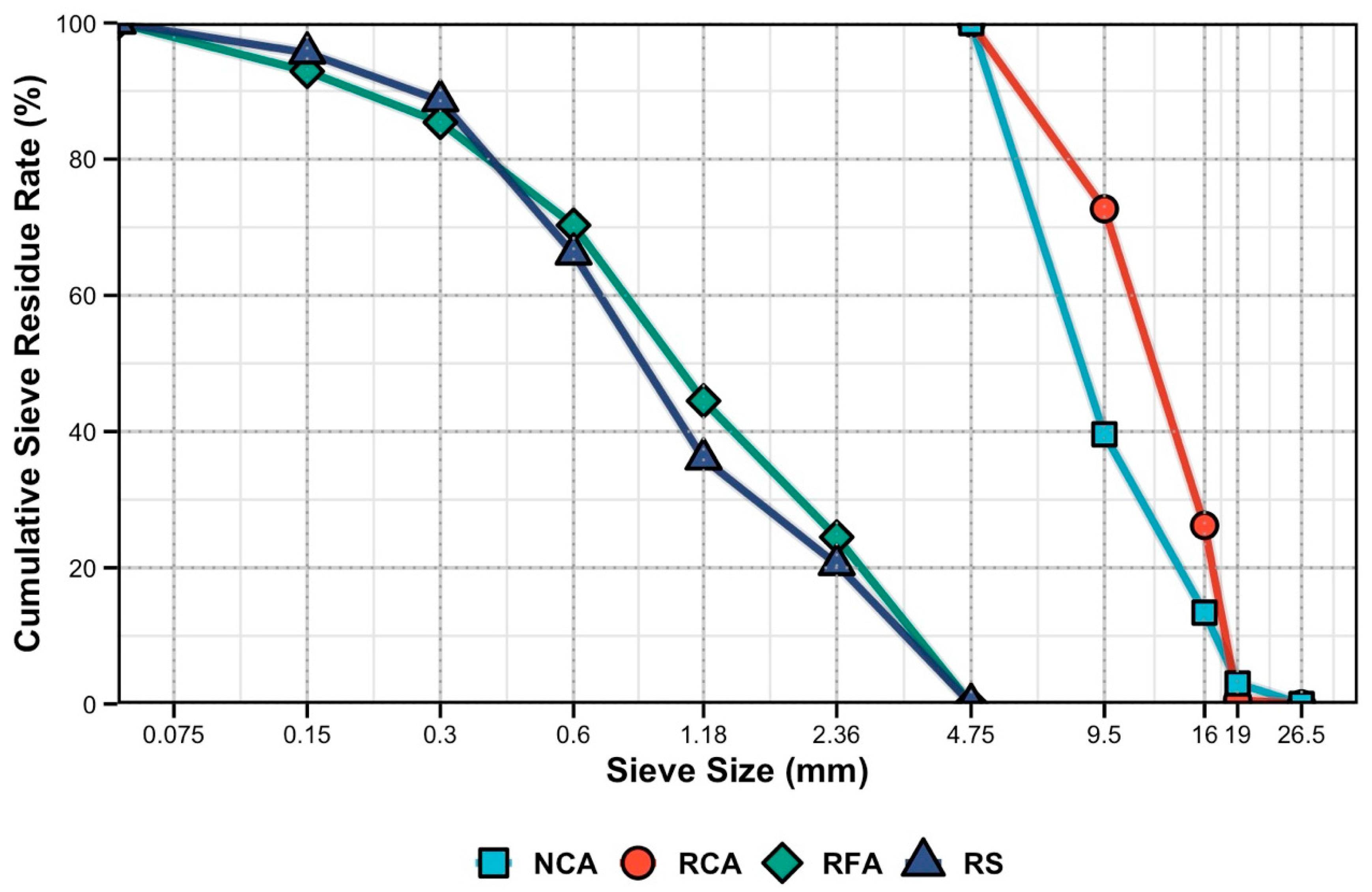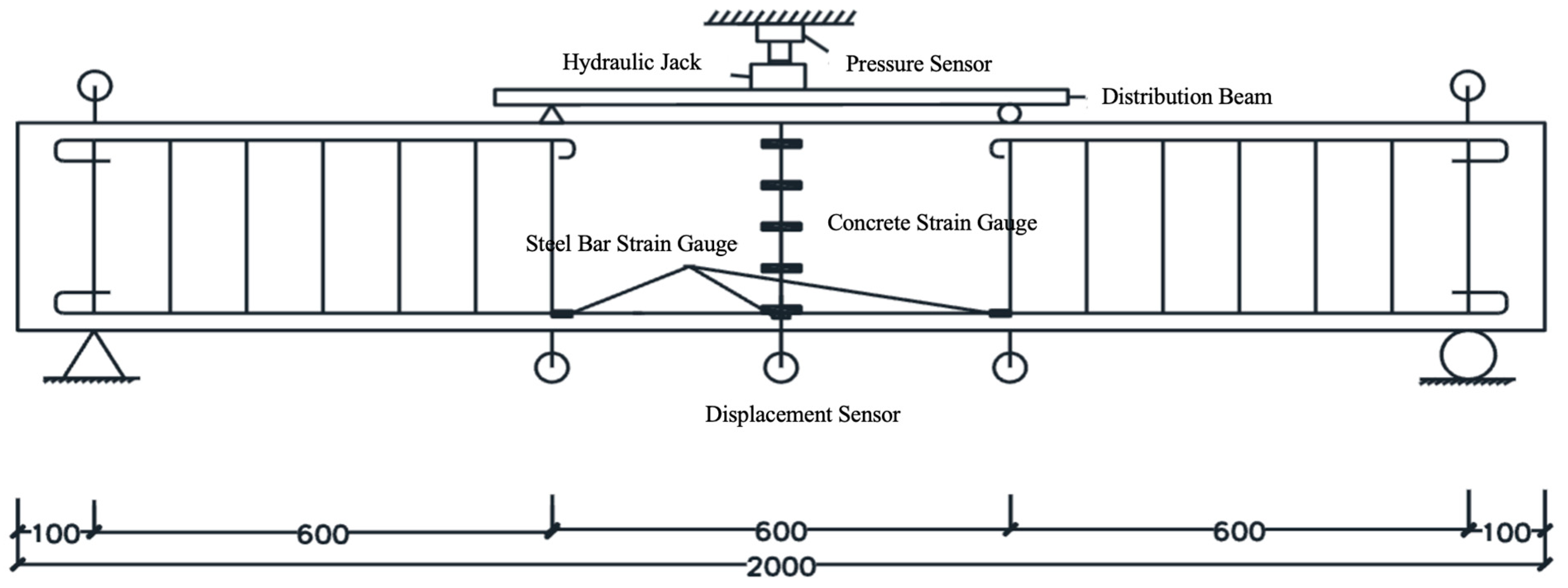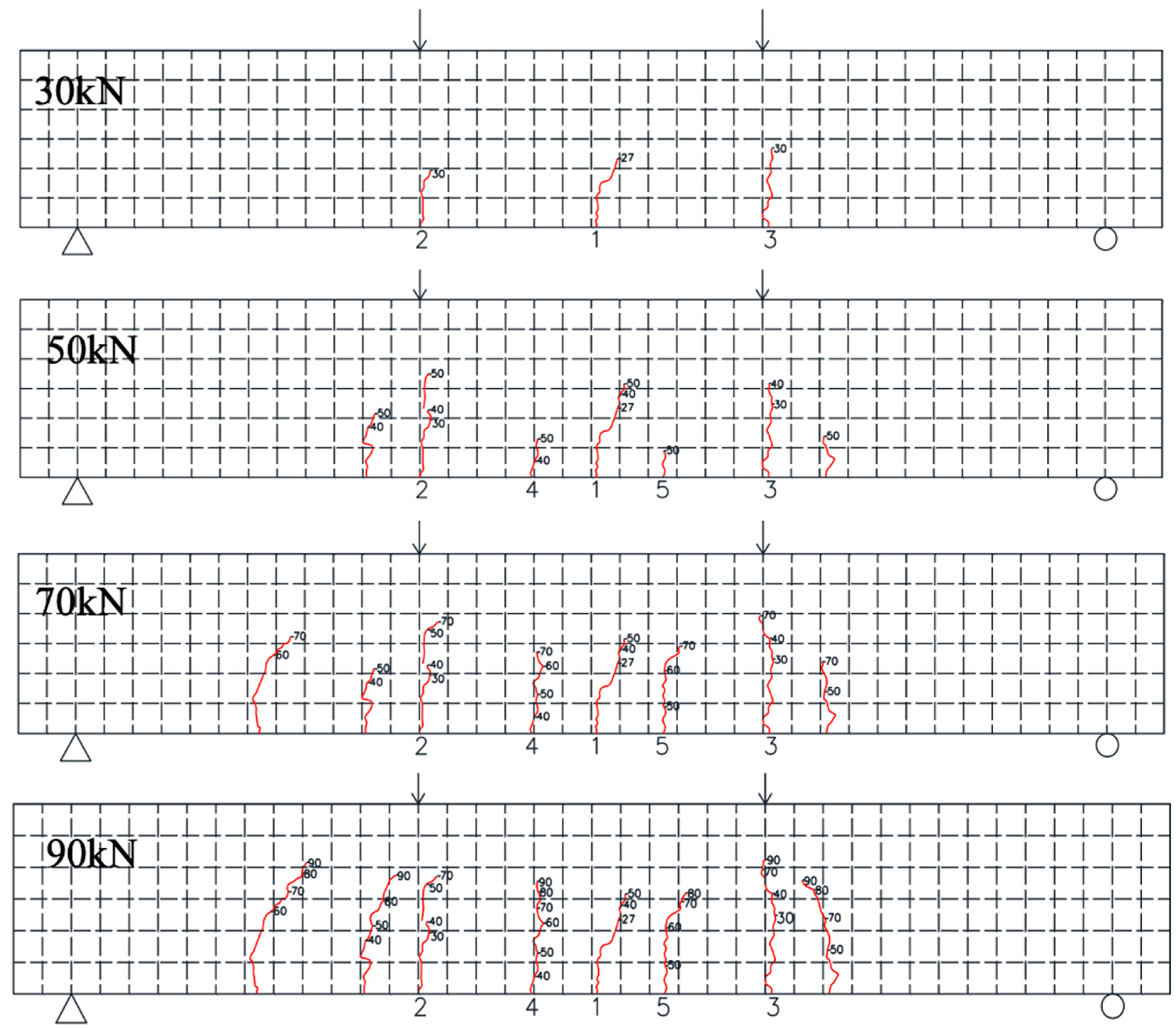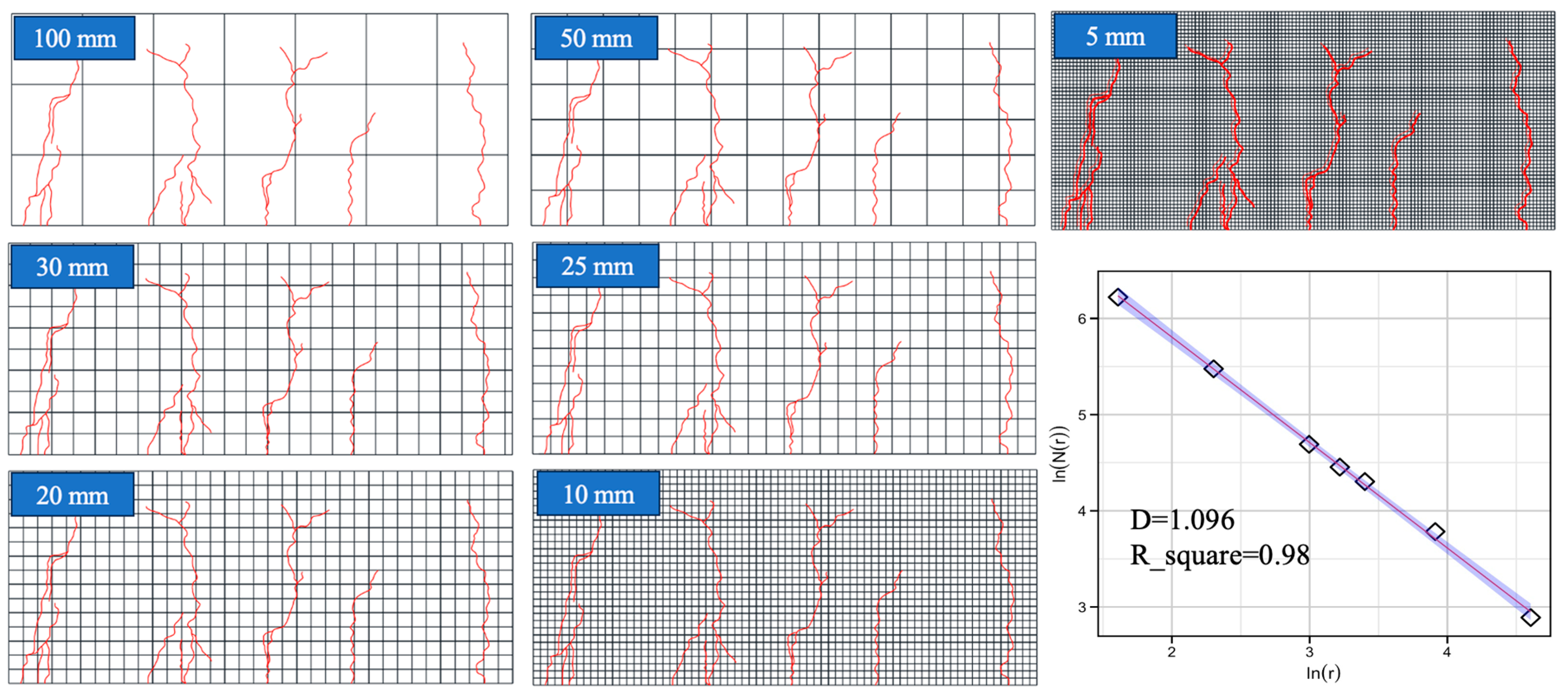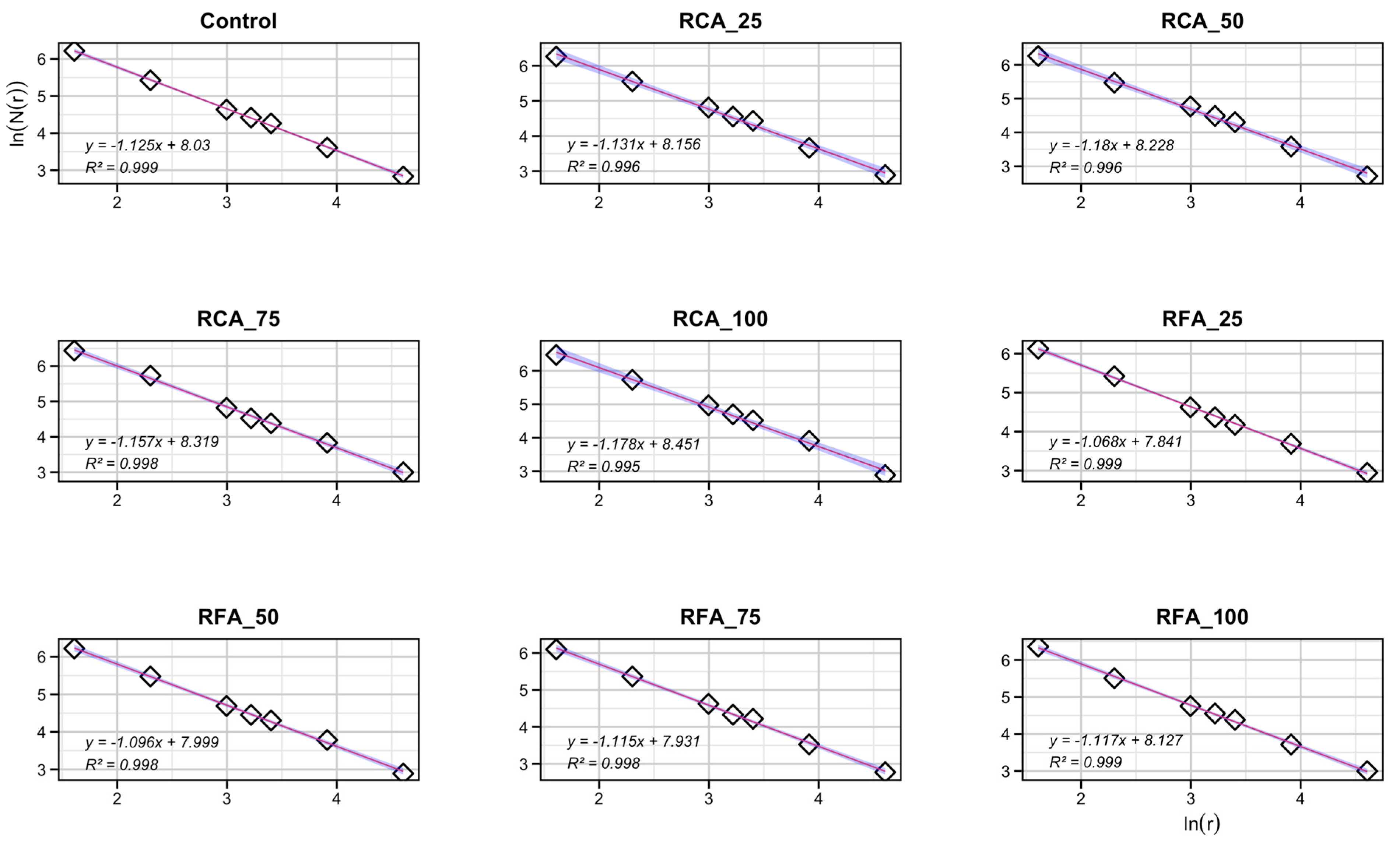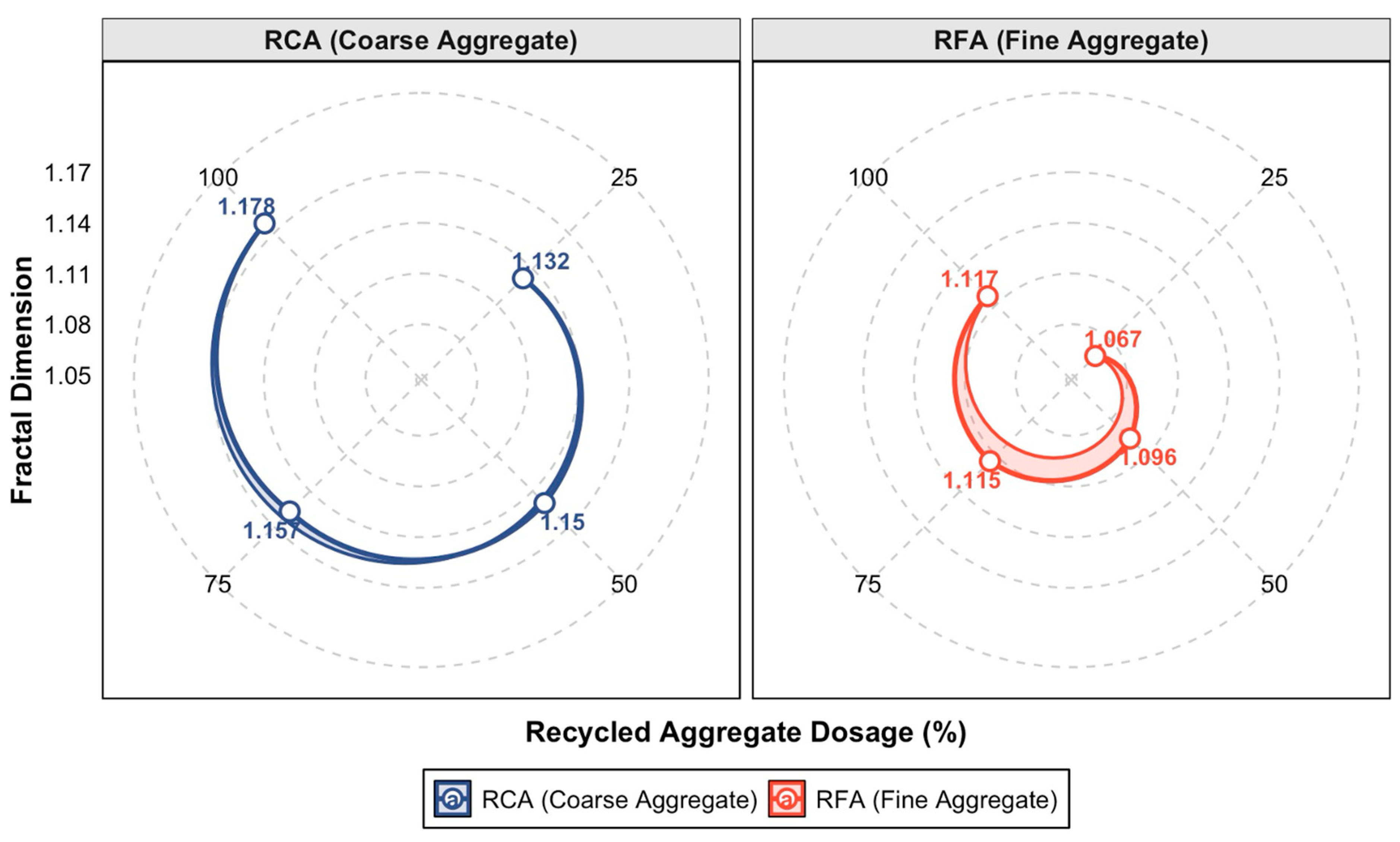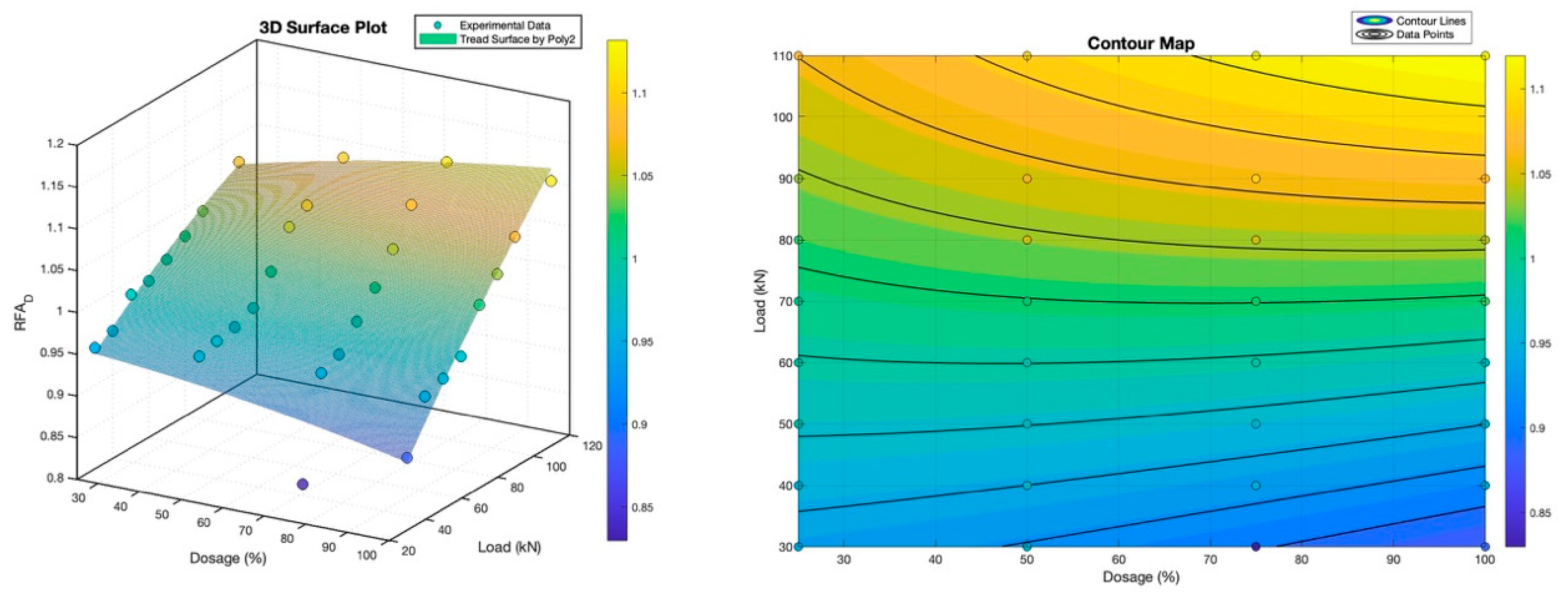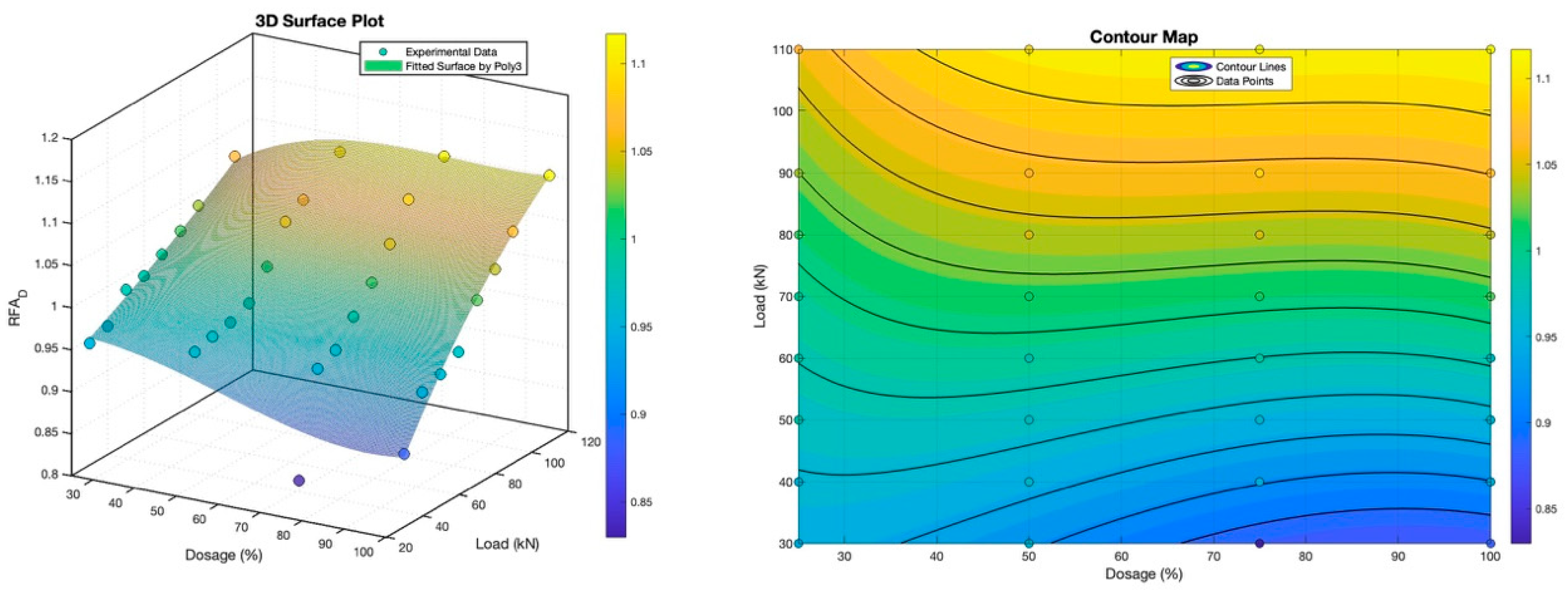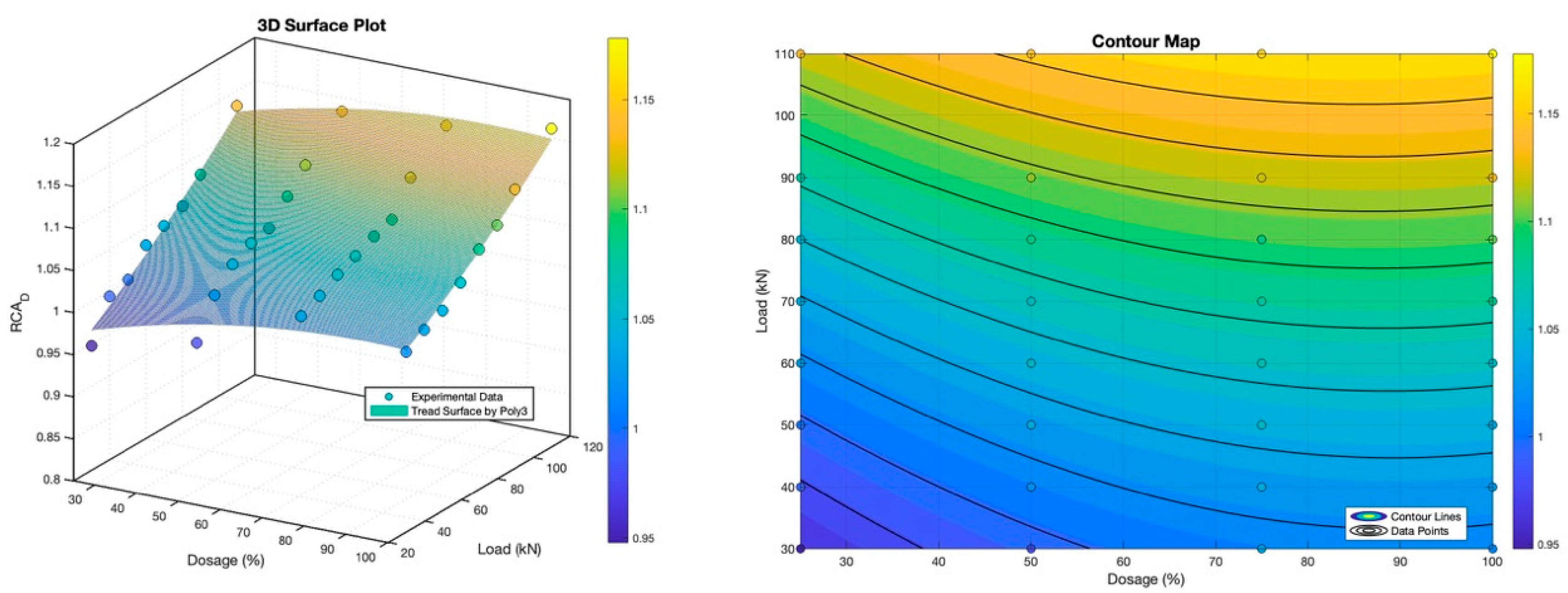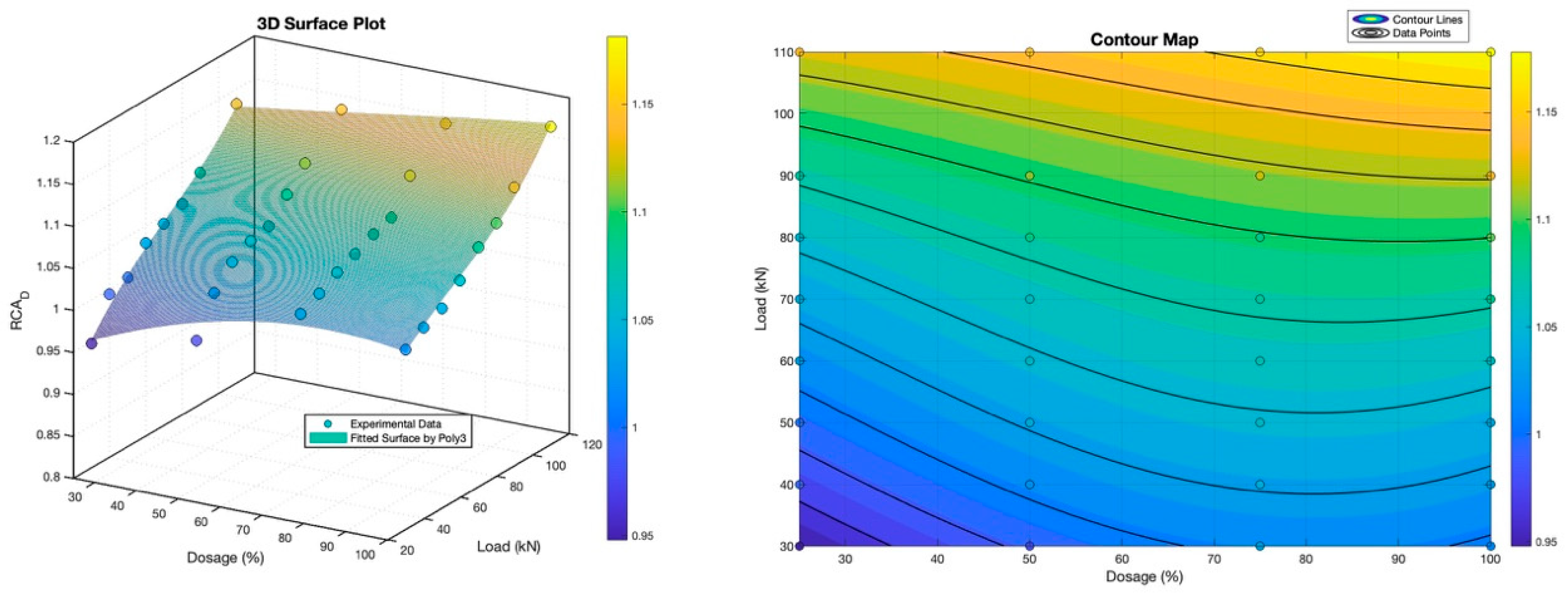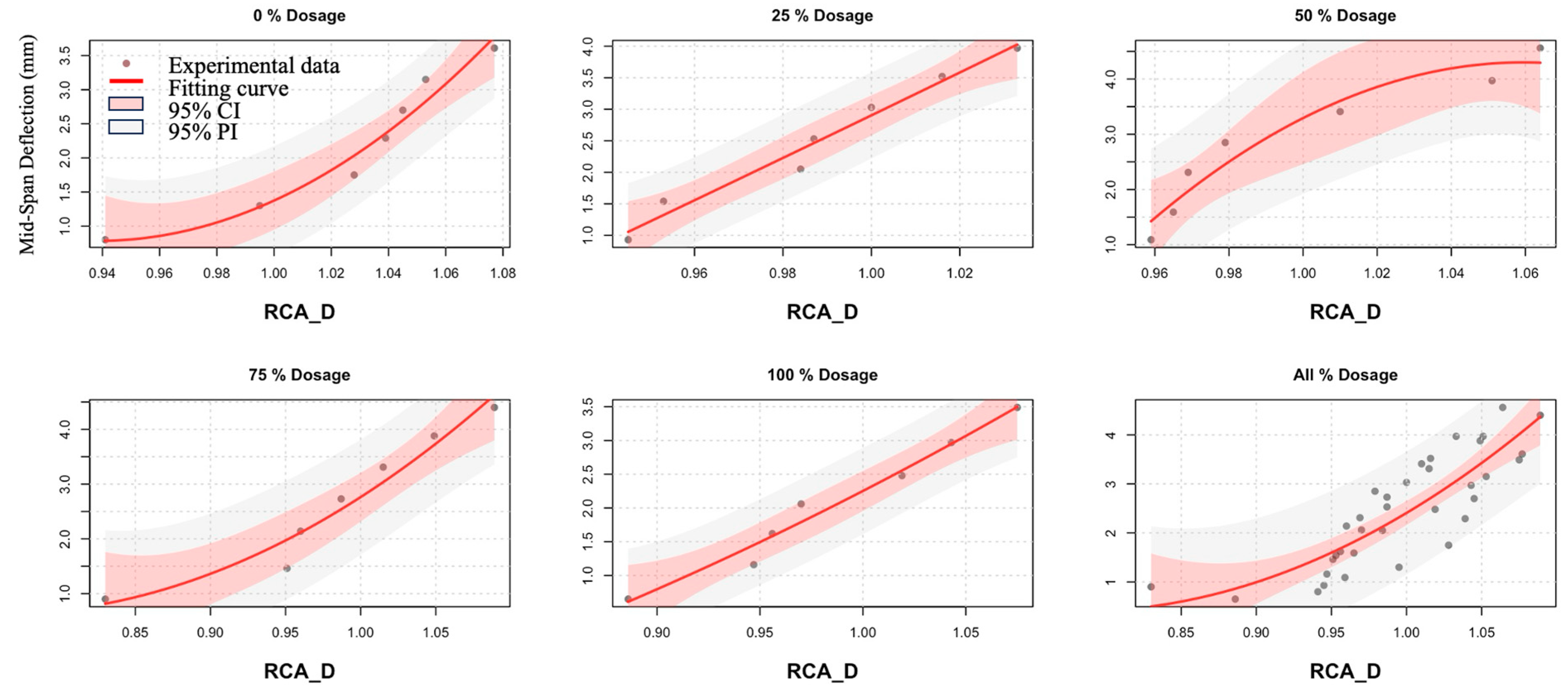3.1. Fractal Characterization of Cracks in the Pure Bending Zone at Ultimate Failure State
Following the ultimate failure in all nine beam specimens, the crack patterns within their respective pure bending zones underwent systematic grid partitioning using the previously described methodology. The crack-occupied cell counts derived from this multi-scale analysis are used for illustration. Scatter plots depicting the relationship between lnN(r) and ln(r) were subsequently generated for each specimen, followed by linear regression analysis. This analytical sequence culminated in the determination of fractal dimensions (D) for each beam specimen at their ultimate failure state, with results graphically presented in
Figure 6. From the scatter plots of linear regression for ln
N(
r) vs. ln(
r) at ultimate failure states, it is evident that all test specimens exhibit linear correlations. This observation indicates that the crack propagation patterns in recycled aggregate concrete beams during flexural loading demonstrate self-similar characteristics, thereby validating the applicability of fractal theory for crack analysis. The fractal dimensions, as illustrated in
Figure 7, were determined through the slopes of these linear regressions.
As illustrated in
Figure 7, the fractal dimensions of the analyzed beam specimens exhibit values ranging from 1.0 to 1.2. Notably, the RCA100 beam demonstrates the highest fractal dimension, while the RFA25 beam presents the lowest. Under equivalent replacement ratios, concrete beams containing recycled coarse aggregates consistently exhibit higher fractal dimensions compared to those with recycled fine aggregates. This observation stems from the inherent material properties of recycled coarse aggregates, characterized by relatively lower elastic moduli and compressive strengths when contrasted with fine aggregate counterparts [
6,
7]. During the failure regime, following the yielding and subsequent withdrawal from service of tensile reinforcement, the compressed concrete zone assumes primary load-bearing responsibility. Experimental evidence indicates that recycled coarse aggregate concrete beams manifest diminished deformation resistance and reduced ductility relative to fine aggregate variants, resulting in more pronounced late-stage crack propagation. Given the established correlation between fractal dimension and crack morphological complexity, it follows logically that recycled coarse aggregate concrete beams exhibit elevated fractal dimensions. For specimens with identical replacement configurations, a direct proportionality exists between crack fractal dimensions and recycled coarse aggregate replacement ratios, implying that increased coarse aggregate substitution promotes more extensive crack development and exacerbates damage severity. Conversely, recycled fine aggregate replacement ratios demonstrate a nonlinear relationship with crack fractal dimensions, exhibiting an initial decrease followed by a subsequent increase.
Consistently, recycled fine aggregate concrete beams exhibit lower fractal dimensions compared to conventional ordinary concrete beams. This phenomenon primarily arises from the angular surface morphology and irregular particle shape of recycled fine aggregates, which induce an interlocking effect with neighboring aggregate components. Furthermore, the enhanced bond performance between recycled fine aggregates and steel reinforcement, when compared to conventional concrete matrices, results in superior interface anchorage characteristics. Collectively, these factors contribute to the crack-inhibiting properties of recycled fine aggregate incorporation, demonstrating a marked crack-arresting effect in reinforced concrete elements.
3.2. Fractal Characteristics of Cracks in Pure Bending Sections Under Varying Loads
The fractal analysis of crack evolution in recycled aggregate concrete beams under pure bending conditions reveals significant load-dependent morphological complexity (see
Figure 8,
Figure 9,
Figure 10 and
Figure 11). Utilizing a box-counting algorithm, the fractal dimensions (D) of surface fractures were quantified across varying load regimes, establishing a direct correlation between mechanical stress and crack self-organization patterns. In the initial elastic phase, crack propagation exhibited limited spatial development, with lnN(r)-ln(r) slopes below unity, indicating negligible self-similarity. However, as applied loads approached ultimate capacity, the fracture network underwent a marked topological transformation. The observed monotonic increase in fractal dimensions demonstrates a power-law relationship between stress intensity and geometric complexity. Notably, all specimens demonstrated fractal scaling exceeding their topological dimensions (D > D
0), with R
2 > 0.95 confirming statistical self-affinity across measurement scales. A parametric investigation established a linear growth model (F = aD + b) relating the applied load magnitude (F) to the resultant fractal dimension (D). This empirical relationship, validated through multivariable regression analysis, enables predictive modeling of fracture evolution in recycled aggregate concrete systems. Microstructural examination suggests that increasing load induces hierarchical branching mechanisms, transitioning from primary crack propagation to secondary fracture network formation.
The crack morphology exhibits three distinct fractal regimes: (1) a linear distribution (1.10 ≤ D ≤ 1.40) characterized by isolated fracture paths, (2) a surface distribution (1.30 ≤ D ≤ 1.60) featuring interacting crack families, and (3) a network distribution (1.50 ≤ D ≤ 1.90) showing percolating fracture patterns. Experimental observations confirm that recycled aggregate concrete beams predominantly operate within the linear fractal regime under service loads, with critical failure marked by a sudden transition to surface distribution patterns. These findings contribute to damage mechanics frameworks by establishing the fractal dimension as a quantitative damage index. The observed load-dependent fractal escalation provides critical insight into energy-dissipation mechanisms and failure precursors in cementitious composites.
The four charts collectively illustrate the intricate relationships between the dosage of RFA and RCA, applied load, and the fractal dimension (D) of crack propagation in concrete beams, employing both second-order and third-order polynomial trend surface fitting. These figures are used to assess the implications of recycled aggregate-induced crack complexity variations.
Figure 8, depicting a 3D surface plot and contour map for RFA_D, reveals a fitted formula indicating a negative quadratic influence of dosage and a positive linear effect of load on RFA_D, suggesting that while an increased RFA dosage initially reduces crack complexity, higher loads amplify it. The R-squared value of 0.9201 underscores the model’s strong explanatory power.
Figure 9, focusing on RFA dosage variation under incremental loading, corroborates the negative dosage effect and positive load impact, with an interaction term highlighting that the dosage’s influence on RFA_D becomes more pronounced with rising load, as evidenced by an R-squared of 0.9353. Shifting focus to RCA,
Figure 10, utilizing a second-order polynomial, demonstrates positive linear relationships between RCA dosage, load, and RCA_D, implying that a higher RCA content and increased load both elevate crack complexity. The negligible interaction term suggests a minimal combined effect, yet the model explains 96.53% of RCA_D variance.
Figure 11, employing a third-order polynomial for RCA dosage analysis, reveals a more nuanced relationship: while RCA dosage and load positively influence RCA_D linearly, negative quadratic and cubic terms indicate a potential plateau or reversal in crack complexity at extremely high dosages or loads. The exceptional R-squared value of 0.9779 attests to the model’s remarkable fit.
The observed disparities in crack propagation behavior between RFA and RCA-incorporated concretes can be attributed to the inherent physicochemical characteristics of these recycled aggregate types. RFA, typically characterized by a higher water absorption capacity and porous structure compared to natural fine aggregates, may introduce more micro-voids and weak interfaces within the concrete matrix [
24]. These defects can act as stress concentrators, potentially promoting localized crack initiation and coalescence under load. However, the negative quadratic relationship between RFA dosage and RFA_D suggests that beyond a certain threshold, the increased porosity and weakened interfacial transition zone might lead to a more homogeneous crack propagation path, thereby reducing the fractal complexity. Conversely, RCA, often containing a significant portion of adhered mortar and exhibiting a rougher surface texture than natural coarse aggregates, can enhance the mechanical interlocking and friction at the aggregate–cement paste interface. This improved interfacial bonding could contribute to a more tortuous crack path, as cracks are forced to deviate around the angular RCA particles, thereby increasing the fractal dimension (RCA_D). The positive linear relationship between RCA dosage and RCA_D supports this notion, indicating that higher RCA content amplifies this crack deviation mechanism. Furthermore, the applied load plays a pivotal role in modulating crack propagation. Higher loads accelerate crack initiation and propagation, amplifying the inherent tendencies dictated by the aggregate type and dosage. The interaction terms observed in the fitting formulas suggest that the effect of aggregate dosage on fractal dimension is load-dependent, highlighting the synergistic interplay between material composition and mechanical loading in governing the fracture behavior of concrete. Collectively, these charts elucidate that RFA and RCA exert opposing effects on crack fractal dimension, with dosage and load interacting to modulate crack propagation patterns. These findings offer valuable insights for optimizing concrete mixtures, balancing recycled aggregate utilization with desired structural performance, while also highlighting the need for cautious extrapolation beyond the tested dosage and load ranges.
3.3. Relationship Between Fractal Dimension and Mid-Span Deflection
Figure 12 presents a series of graphs that show the correlation between the fractal dimension of cracks (RCA_D) and the mid-span deflection of concrete beams incorporating varying proportions of recycled coarse aggregate (RCA). The different proportions examined are 0%, 25%, 50%, 75%, and 100%, along with a comprehensive “All Dosages” category. Each graph is composed of data points (depicted as gray dots), a quadratic regression curve (shown in red), and 95% confidence intervals (represented by the red-shaded area).
At a 0% recycled coarse aggregate dosage, the quadratic regression equation Deflection = 137.5 − 291.5RCA_D + 155.3RCA_D2, with an R2 of 0.94, demonstrates a strong fit of the quadratic model to the experimental data. As the fractal dimension of cracks increases, the mid-span deflection of the beam exhibits a nonlinear upward trend. In the absence of recycled coarse aggregate, the beam possesses a specific level of inherent stiffness. With the growth in crack complexity (quantified by the fractal dimension), the deflection gradually escalates as the beam’s ability to carry loads diminishes. When the recycled coarse aggregate dosage reaches 25%, the equation Deflection = 95.33 − 212.1RCA_D + 118.4RCA_D2, with an R2 of 0.96, shows a clear nonlinear relationship between deflection and the crack fractal dimension. Compared to the 0% dosage scenario, the initial deflection is lower. This can be attributed to the impact of the recycled coarse aggregate on the beam’s material properties, which makes the beam slightly more deformable or reduces its initial stiffness.
At a 50% recycled coarse aggregate dosage, the equation Deflection = −27.84 + 20.48RCA_D + 7.498RCA_D2 (R2 = 0.92) indicates a nonlinear increase in deflection as the crack fractal dimension rises. The presence of 50% recycled coarse aggregate heightens the beam’s sensitivity to crack development, resulting in more significant deflection changes for a given change in the fractal dimension. For a 75% recycled coarse aggregate dosage, the quadratic regression Deflection = −332.3 + 584.4RCA_D − 253.5RCA_D2 shows a nonlinear increase in deflection with the crack fractal dimension. The relatively high coefficients compared to lower dosages suggest that at this high level of recycled coarse aggregate content, the beam’s behavior is greatly influenced by the recycled material, leading to a more pronounced deflection response as cracks develop. At a 100% recycled coarse aggregate replacement, the equation Deflection = −158.5 + 273.2RCA_D − 114.1RCA_D2, with an R2 of 0.95, shows that the nonlinear relationship between deflection and the crack fractal dimension persists. The initial deflection is relatively low, and the increase in deflection with the fractal dimension is determined by the unique characteristics of the fully recycled coarse aggregate beam. The “All Dosages” combined graph presents an overall nonlinear trend of deflection increasing with the crack fractal dimension across all recycled coarse aggregate dosages. The data points from different dosages are dispersed around the quadratic regression curve, and the 95% confidence interval provides an estimate of the uncertainty associated with the regression model.
The underlying mechanisms behind these observed relationships are closely related to the properties of recycled coarse aggregate. Recycled coarse aggregate typically has different physical and mechanical characteristics compared to natural aggregate, such as higher porosity, lower density, and weaker interfacial transition zones between the aggregate and the cement paste [
10,
25,
26]. These factors reduce the overall stiffness and strength of the concrete beam. As the dosage of recycled coarse aggregate increases, the beam becomes more susceptible to deformation under load, which is reflected in the increasing deflection with the development of cracks (higher fractal dimension). Additionally, the nonlinear relationship between the fractal dimension and deflection can be explained by the nonlinear decrease in the beam’s load-carrying capacity as cracks develop and coalesce. The dosage-dependent behavior is due to the cumulative effect of the recycled coarse aggregate’s properties on the beam’s performance, with different dosages leading to varying degrees of influence on the deflection–crack fractal dimension relationship.
Figure 13 presents a set of graphs and comprehensively depicts the relationship between the fractal dimension of cracks (RFA_D) and the mid-span deflection of beams under varying dosages of recycled fine aggregate (RFA), encompassing 0%, 25%, 50%, 75%, 100%, and an “All Dosages” scenario. Each graph is equipped with data points (gray dots), a quadratic fit curve (red line), and 95% confidence intervals (shaded red area), providing a detailed and nuanced view of this relationship.
At a 0% dosage of recycled fine aggregate, the quadratic fit equation Deflection = 137.5 − 291.5RFA_D + 155.3RFA_D2, with an R2 value of 0.94, indicates a relatively good fit of the quadratic model to the data. This implies a nonlinear increasing trend in the mid-span deflection of the beam as the fractal dimension of cracks increases. In the absence of recycled fine aggregate, the beam possesses a certain inherent stiffness. As the complexity of cracks, represented by the fractal dimension, rises, the deflection gradually increases due to the weakening of the beam’s load-carrying capacity as cracks propagate. When the dosage of recycled fine aggregate is 25%, the equation Deflection = −25.92 + 23.76RFA_D + 5.054RFA_D2, with an R2 of 0.9732, shows a nonlinear increase in deflection with the increase in the crack fractal dimension as well. Compared to the 0% dosage case, the initial deflection value is lower. This can be attributed to the influence of the recycled fine aggregate on the material properties of the beam. The recycled fine aggregate may alter the beam’s stiffness, making it slightly more flexible or reducing its initial resistance to deformation.
At a 50% dosage, the equation Deflection = −314.9 + 602.6RFA_D − 284.4RFA_D2 (R2 = 0.96) further illustrates the nonlinear relationship. The higher coefficients compared to lower dosages suggest that at this level of recycled fine aggregate content, the beam’s response to crack development is more sensitive. A given change in the fractal dimension results in larger deflection changes, indicating that the presence of a significant amount of recycled fine aggregate amplifies the beam’s susceptibility to deformation as cracks become more complex. For a 75% dosage, the quadratic fit Deflection = 21.6 + −55.33RFA_D + 36.5RFA_D2, R2 = 0.9517, still shows a nonlinear increase in deflection with the crack fractal dimension. The relatively lower coefficients compared to the 50% dosage case may imply that as the recycled fine aggregate dosage approaches 75%, the beam’s behavior starts to stabilize to some extent. However, it still clearly demonstrates a relationship with crack complexity, as the propagation of more complex cracks continues to cause deflection. At a 100% recycled fine aggregate replacement, the equation Deflection = −1.75 + −7.728RFA_D + 11.73RFA_D2, R2 = 0.9726, shows that the nonlinear relationship between deflection and the crack fractal dimension persists. The initial deflection is relatively low, and the increase in deflection with the fractal dimension is more moderate compared to some intermediate dosages. This could be due to the unique properties of the fully recycled fine aggregate beam, where the beam’s behavior may be dominated by the characteristics of the recycled fine aggregate, leading to a more stable or moderate increase in deflection as cracks develop. The combined “All Dosages” graph presents an overall nonlinear trend of deflection increasing with the crack fractal dimension across all recycled fine aggregate dosages. The data points from different dosages are scattered around the quadratic fit curve, and the 95% confidence interval provides an estimate of the uncertainty in the fit, offering a comprehensive view of the general pattern.
The underlying mechanisms behind these observed relationships are multifaceted. Firstly, recycled fine aggregate typically exhibits different physical and mechanical properties compared to natural aggregate. It often has higher porosity, lower density, and weaker interfacial transition zones between the aggregate and the cement paste. These factors collectively reduce the overall stiffness and strength of the concrete beam. As the dosage of recycled fine aggregate increases, the beam becomes more prone to deformation under load, which is reflected in the increasing deflection with the development of cracks (higher fractal dimension). Secondly, the fractal dimension of cracks serves as a measure of their complexity. As the load on the beam increases, micro-cracks initiate and propagate. In beams with recycled fine aggregate, the weaker interfacial zones and lower overall strength may lead to more complex crack patterns (higher fractal dimensions) at a given load level [
27,
28,
29]. The propagation of these complex cracks causes the beam to deflect more. The nonlinear relationship between the fractal dimension and deflection can be attributed to the fact that as cracks develop and coalesce, the beam’s load-carrying capacity decreases nonlinearly, resulting in a more rapid increase in deflection. Lastly, the dosage-dependent behavior can be explained as follows. At low dosages of recycled fine aggregate, the influence on the beam’s properties is relatively small, and the deflection–crack fractal dimension relationship is similar to that of the control (0% dosage), but with some differences in initial stiffness. As the dosage increases, the cumulative effect of the recycled fine aggregate’s inferior properties becomes more pronounced, leading to larger deflections for a given crack fractal dimension. However, at very high dosages (e.g., 100%), the beam may reach a state where its behavior is dominated by the recycled fine aggregate properties, and the increase in deflection with the crack fractal dimension may become more stable or moderate. In conclusion, the relationship between the fractal dimension of cracks and the mid-span deflection of beams is significantly influenced by the dosage of recycled fine aggregate. The nonlinear relationship is a result of the complex interaction between the recycled fine aggregate’s properties and the crack development process in the concrete beam.
Theoretically, the fractal dimension demonstrates superior sensitivity to microstructural changes, capturing early-stage crack coalescence that remains undetected by displacement measurements. This spatial complexity metric also enables precise damage localization, a resolution unattainable through global deflection analysis. Practically, the fractal approach facilitates cost-effective non-contact monitoring using standard imaging systems, achieving high-level correlation with laser displacement data while reducing sensor costs when integrated into a hierarchical structural health monitoring framework. Fractal dimension spikes precede critical deflection thresholds, serving as an earlier failure precursor. In addition, by fusing fractal dimension with deflection metrics in a hybrid damage index, prediction accuracy can be improved compared to single-parameter models. This dual-parameter approach enables real-time image-based screening complemented by targeted deflection verification, maintaining high-level failure prediction reliability. The findings position fractal analysis as a practical tool for early damage detection, data-driven prognostic modeling, and economically viable bridge assessment systems, with future work focused on automating damage classification through machine learning and full-scale field validation.
